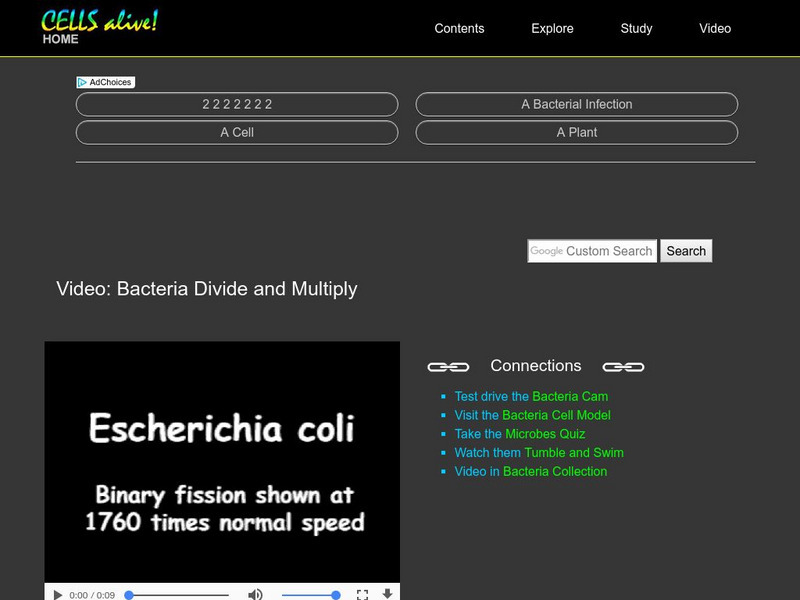CK-12 Foundation
Ck 12: Life Science: 2.22 Reproduction
Explore the different ways that animals and plants reproduce.
Biology Pages
Kimball's Biology Pages: Asexual Reproduction
Site from Kimball's Biology Pages provides information on Asexual Reproduction in plants, and also in animals, where it is less common. Includes information on stems, leaves, roots, plant propagation and apomixis.
Biology Pages
Kimball's Biology Pages: Asexual Reproduction
Everything you've ever needed to know regarding asexual reproduction. Modules include Asexual Reproduction in Plants, Asexual Reproduction in Animals, Why Choose Asexual Reproduction? Materials can be used as supplemental resources or as...
Cosmo Learning
Cosmo Learning: Video: Mitosis in Real Time
Can you identify the steps of mitosis in this video? The video shows the process of the nucleus of a eukaryotic cell dividing in real time. [0:19]
Bio Topics
Bio Topics: Asexual Reproduction and Artificial Propagation
A worksheet and notes regarding asexual reproduction and artificial propagation.
Cells Alive
Cells Alive: Bacterial Growth
This site provides a brief explanation of how bacteria cells grow and why they do not over run the earth. View actual bacteria growing by way of a time lapse movie.
National Health Museum
Access Excellence: Vegetative Propagation Project
After a short explanation of reproduction methods in plants, this page offers instructions for a vegetative propagation project with results kept in a laboratory journal.
BiologyWise
Biology Wise: Binary Fission Steps
The steps in binary fission during asexual reproduction are explained in this resource.
BiologyWise
Biology Wise: Asexual Reproduction in Plants
Explains the different ways that asexual reproduction can take place in plants.
BiologyWise
Biology Wise: Flowering Plant Reproduction
Discusses asexual and sexual reproduction in flowering plants, the parts of a flower, how pollination takes place, fertilization, and seed development.
BiologyWise
Biology Wise: How Do Bacteria Reproduce
Bacteria mainly reproduce asexually but some also use sexual reproduction. Two forms of asexual reproduction in bacteria are described - binary fission and budding, as well as sexual reproduction.
BiologyWise
Biology Wise: Advantages of Asexual Reproduction
Describes some advantages to asexual reproduction.
BiologyWise
Biology Wise: What Is Vegetative Reproduction
Explains the method of asexual reproduction in plants known as vegetative reproduction and what its advantages and disadvantages are.
BiologyWise
Biology Wise: Asexual vs. Sexual Reproduction
Describes what happens during sexual and asexual reproduction and the advantages and disadvantages of each.
BiologyWise
Biology Wise: Reproduction in Algae
Algae are not uniform in their methods of reproduction. Some reproduce sexually and others asexually. Read a brief overview of algae reproduction in this resource.
BiologyWise
Biology Wise: Platyhelminthes Reproduction
Describes the characteristics of Platyhelminthes, or flatworms, and how they reproduce.
BiologyWise
Biology Wise: Paramecium Reproduction
Describes the characteristics of paramecium and how they reproduce both sexually and asexually.
BiologyWise
Biology Wise: Diatoms Reproduction
Diatoms are a type of algae that reproduces both sexually and asexually. Its characteristics and methods of reproduction are described here.
BiologyWise
Biology Wise: Euglena Reproduction
The characteristics of euglena, a type of protist, and its method of asexual reproduction are described in this resource.
BiologyWise
Biology Wise: Amoeba Facts
Presents facts about amoebas, including their physical characteristics, reproduction, and classification.
BiologyWise
Biology Wise: Facts About Daphnia (Water Fleas)
Describes the physical characteristics of Daphnia, their importance as a food source for freshwater fish, their diet, life cycle, and methods of reproduction. Offers tips for how to start and maintain a colony of Daphnia that can be used...
BiologyWise
Biology Wise: Gametophyte and Sporophyte
This resource explains how the alternation of generations occurs in a plant's life cycle where sporophytes and gametophytes each play a role in plant reproduction.
McGraw Hill
The Mc Graw Hill Companies, Inc.: Asexual Reproduction
The succinct site covers what asexual reproduction is in plants, describes how stolons and rhizomes produce new plants, and discusses human cloning techniques.







